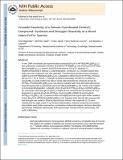Versatile Reactivity of a Solvent-Coordinated Diiron(II) Compound: Synthesis and Dioxygen Reactivity of a Mixed-Valent Fe [superscript II] Fe [superscript III] Species
Author(s)
Majumdar, Amit; Apfel, Ulf-Peter; Jiang, Yunbo; Moenne-Loccoz, Pierre; Lippard, Stephen J.
DownloadLippard_Versatile reactivity.pdf (2.549Mb)
PUBLISHER_POLICY
Publisher Policy
Article is made available in accordance with the publisher's policy and may be subject to US copyright law. Please refer to the publisher's site for terms of use.
Terms of use
Metadata
Show full item recordAbstract
A new, DMF-coordinated, preorganized diiron compound [Fe[subscript 2](N-Et-HPTB)(DMF)[subscript 4]](BF[subscript 4])[subscript 3] (1) was synthesized, avoiding the formation of [Fe(N-Et-HPTB)](BF4)2 (10) and [Fe2(N-Et-HPTB)(μ-MeCONH)](BF[subscript 4])[subscript 2] (11), where N-Et-HPTB is the anion of N,N,N′,N′-tetrakis[2-(1-ethylbenzimidazolyl)]-2-hydroxy-1,3-diaminopropane. Compound 1 is a versatile reactant from which nine new compounds have been generated. Transformations include solvent exchange to yield [Fe[subscript 2](N-Et-HPTB)(MeCN)[subscript 4]](BF[subscript 4])[subscript 3] (2), substitution to afford [Fe[subscript 2](N-Et-HPTB)(μ-RCOO)](BF[subscript 4])[subscript 2] (3, R = Ph; 4, RCOO = 4-methyl-2,6-diphenyl benzoate]), one-electron oxidation by (Cp[subscript 2]Fe)(BF[subscript 4]) to yield a Robin–Day class II mixed-valent diiron(II,III) compound, [Fe[subscript 2](N-Et-HPTB)(μ-PhCOO)(DMF)[subscript 2]](BF[subscript 4])[subscript 3] (5), two-electron oxidation with tris(4-bromophenyl)aminium hexachloroantimonate to generate [Fe[subscript 2](N-Et-HPTB)Cl[subscript 3](DMF)](BF[subscript 4])[subscript 2] (6), reaction with (2,2,6,6-tetramethylpiperidin-1-yl)oxyl to form [Fe[subscript 5](N-Et-HPTB)[subscript 2](μ-OH)[subscript 4](μ-O)(DMF)[subscript 2]](BF[subscript 4])[subscript 4] (7), and reaction with dioxygen to yield an unstable peroxo compound that decomposes at room temperature to generate [Fe[subscript 4](N-Et-HPTB)2(μ-O)[subscript 3](H[subscript 2]O)[subscript 2]](BF[subscript 4])·8DMF (8) and [Fe[subscript 4](N-Et-HPTB)[subscript 2](μ-O)[subscript 4]](BF[subscript 4])[subscript 2] (9). Compound 5 loses its bridging benzoate ligand upon further oxidation to form [Fe[subscript 2](N-Et-HPTB)(OH)[subscript 2](DMF)[subscript 2]](BF[subscript 4])[subscript 3] (12). Reaction of the diiron(II,III) compound 5 with dioxygen was studied in detail by spectroscopic methods. All compounds (1–12) were characterized by single-crystal X-ray structure determinations. Selected compounds and reaction intermediates were further examined by a combination of elemental analysis, electronic absorption spectroscopy, Mössbauer spectroscopy, EPR spectroscopy, resonance Raman spectroscopy, and cyclic voltammetry.
Date issued
2013-12Department
Massachusetts Institute of Technology. Department of ChemistryJournal
Inorganic Chemistry
Publisher
American Chemical Society (ACS)
Citation
Majumdar, Amit, Ulf-Peter Apfel, Yunbo Jiang, Pierre Moënne-Loccoz, and Stephen J. Lippard. “ Versatile Reactivity of a Solvent-Coordinated Diiron(II) Compound: Synthesis and Dioxygen Reactivity of a Mixed-Valent Fe [superscript II] Fe [superscript III] Species .” Inorg. Chem. 53, no. 1 (January 6, 2014): 167–181.
Version: Author's final manuscript
ISSN
0020-1669
1520-510X